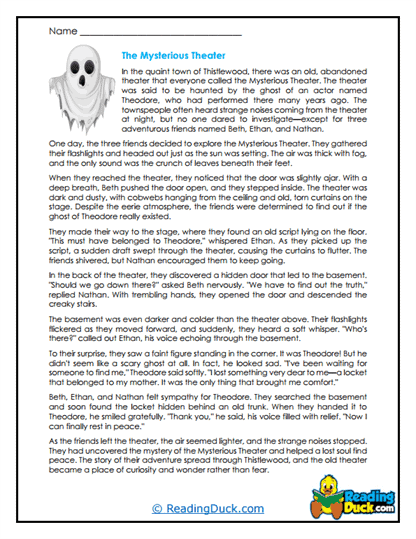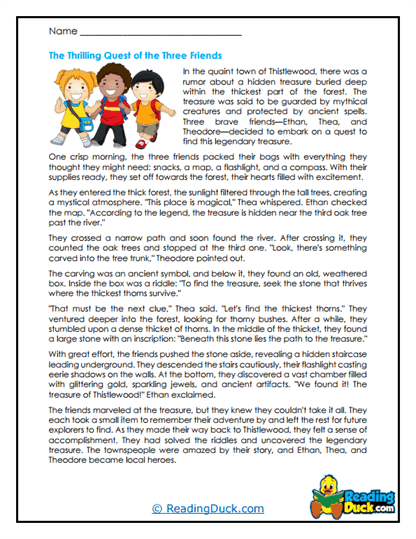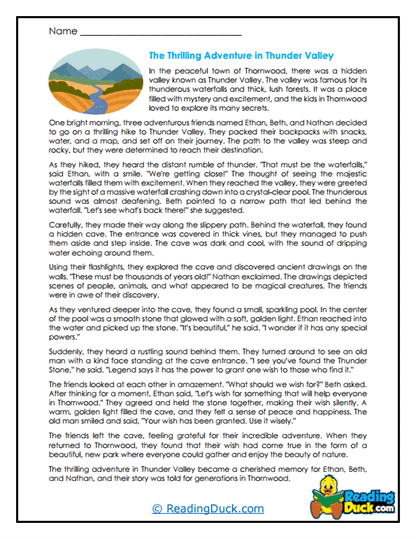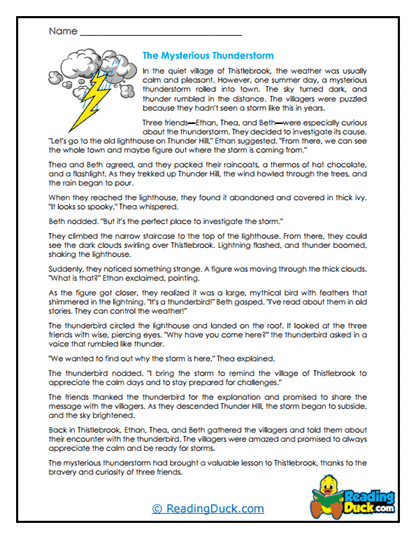Th- Digraph Reading Passages Worksheets
About Our Th- Digraph Reading Passages Worksheets
Our Th- Digraph Reading Passages Worksheets are thoughtfully designed to support students in developing essential phonics skills with a specific focus on the "th" digraph. This collection provides targeted reading passages that help students recognize, decode, and master words that begin with or contain the "th" sound, which can be challenging for early readers. Each worksheet is accompanied by a vibrant, engaging picture that captures young readers' attention and enhances the learning experience by making it more interactive and visually appealing.
In addition to the reading passages, every worksheet includes multiple-choice questions to assess students’ comprehension and understanding of the "th" digraph. These comprehension questions not only reinforce the phonics concepts but also help students improve their critical thinking and overall reading comprehension skills. The worksheets are presented in PDF format, making them simple to download, view, and print for easy use at school or home. Additionally, every worksheet set includes a downloadable answer key for ease of grading, providing teachers, parents, and tutors with a quick reference for assessing student progress.
Our Th- Digraph Reading Passages Worksheets provide an excellent foundation for building phonics skills, enhancing reading fluency, and expanding vocabulary through consistent, focused practice on this essential digraph.
Understanding the Th- Digraph and Its Importance in Phonics
The "th" digraph is a combination of the letters "t" and "h" that come together to produce a unique sound, either voiced or voiceless, as heard in words like "this," "that," "think," and "both." Unlike the individual sounds of "t" or "h," when these letters are combined, they create a new sound pattern that students must learn to recognize and decode. Understanding how and when the "th" digraph appears in words is a critical part of phonics instruction, as it enables students to read more fluently and accurately.
There are two common sounds produced by the "th" digraph:
- Voiced "th": Found in words like "this" and "that," the voiced "th" produces a buzzing sound.
- Voiceless "th": Found in words like "think" and "thank," the voiceless "th" creates a softer, breathy sound.
Mastering these two distinct sounds is essential for reading proficiency, as the "th" digraph appears frequently in early reading materials and in everyday vocabulary. Learning to identify and decode the "th" digraph not only improves reading fluency but also helps students become more confident spellers and writers.
Why the Th- Digraph is Important for Young Readers:
- Foundational Phonics Skill: The "th" digraph is one of the most common in English, making it critical for early readers to master.
- Supports Fluency and Accuracy: Understanding when to use the voiced or voiceless "th" helps students decode words more quickly and accurately, enhancing their reading fluency.
- Improves Phonemic Awareness: Recognizing the unique sound of the "th" digraph supports the development of phonemic awareness, which is crucial for overall literacy growth.
How Th- Digraph Worksheets Build Reading Fluency and Comprehension
Our Th- Digraph Reading Passages Worksheets are specifically designed to help students improve their reading fluency by providing repeated exposure to the "th" digraph in meaningful contexts. Through engaging passages, students practice recognizing and decoding "th" words, which reinforces their phonics knowledge and helps them become more confident, fluent readers.
Key Benefits for Reading Fluency and Comprehension:
- Targeted Phonics Practice: These worksheets focus entirely on the "th" digraph, allowing students to concentrate on one phonics pattern at a time. This focused practice helps students internalize the sound and spelling of the digraph, improving their ability to decode "th" words in various contexts.
- Improving Reading Fluency: Fluency is built when students can read words quickly and accurately. By repeatedly encountering the "th" digraph in different sentences and passages, students become more comfortable with the sound, leading to smoother and faster reading.
- Strengthening Comprehension: Each worksheet includes multiple-choice comprehension questions that test students' understanding of the passage and the digraph. This combination of phonics and comprehension practice ensures that students not only recognize the "th" digraph but also understand the meaning of the text they are reading.
Practical Suggestions for Using Th- Digraph Worksheets in Various Learning Settings
Our Th- Digraph Reading Passages Worksheets are versatile resources that can be used in a variety of instructional settings. Whether you're a teacher, tutor, or parent, these worksheets provide effective phonics practice for early readers. They can be seamlessly integrated into classroom lessons, tutoring sessions, or at-home practice, offering valuable support for students at different stages of their phonics journey.
Tips for Effectively Using Th- Digraph Worksheets:
- Small Group Phonics Instruction: Use these worksheets in small groups to provide focused phonics practice. In this setting, teachers can guide students through the reading passages, helping them identify and decode "th" words while discussing the meaning of the passage as a group. This collaborative approach allows for deeper exploration of the digraph and encourages peer learning.
- Independent Reading Practice: Assign these worksheets as independent reading tasks for students. The multiple-choice comprehension questions allow students to assess their understanding of both the digraph and the passage on their own, fostering independent reading skills.
- Phonics Review Sessions: These worksheets can be used as part of a review lesson on the "th" digraph. After teaching the digraph in class, provide students with these reading passages to reinforce what they've learned and ensure they can apply it in real reading situations.
- Homework Assignments: The convenient PDF format makes it easy to print and send these worksheets home for additional practice. Parents can support their child's phonics development by reviewing the worksheet at home and reinforcing the "th" digraph with real-world reading examples.
- Tutoring Sessions: For one-on-one tutoring, these worksheets provide an excellent tool for focused phonics instruction. Tutors can help students work through the passages and comprehension questions, ensuring that they master the "th" digraph before moving on to more complex phonics concepts.
Reinforcing Phonemic Awareness with Repeated Th- Digraph Practice
One of the most effective ways to teach phonics is through repetition, and our Th- Digraph Reading Passages Worksheets offer students repeated exposure to the "th" sound. Each passage contains numerous examples of "th" digraph words, allowing students to see, hear, and practice the sound in different contexts. This repetition builds phonemic awareness, a foundational skill for literacy that helps students identify and manipulate sounds in words.
Why Repetition is Key to Phonics Success:
- Improves Word Recognition: The more often students encounter the "th" digraph, the quicker they become at recognizing it in new words. This improves their reading speed and fluency, as they no longer need to pause and decode every time they see the digraph.
- Boosts Confidence: Repeated practice with the "th" digraph builds students' confidence in their phonics skills. As they become more familiar with the sound pattern, they can tackle more challenging texts with ease.
- Sharpens Decoding Skills: Regular practice with "th" words helps students strengthen their decoding abilities. As they learn to break words down into individual sounds, they become more proficient at reading complex words and sentences.
Vocabulary Building Through Th- Digraph Reading Passages
In addition to improving phonics skills, our Th- Digraph Reading Passages Worksheets help students expand their vocabulary. Each passage contains a variety of "th" digraph words, which students encounter in context. This exposure to new vocabulary not only helps students understand the meaning of "th" words but also enhances their overall language development.
How Vocabulary Expansion Supports Literacy:
- Contextual Learning: Seeing "th" words used in meaningful sentences and passages helps students understand their meaning and application. This type of contextual learning is critical for retaining new vocabulary and applying it in everyday reading and writing.
- Broader Language Development: Learning new words with the "th" digraph strengthens students' overall language skills. As their vocabulary grows, so does their ability to comprehend more complex texts and express themselves in writing.
- Real-World Application: The vocabulary learned through these worksheets can be applied to real-world reading tasks, helping students build practical language skills they can use in school and beyond.
Conclusion
Our Th- Digraph Reading Passages Worksheets are an invaluable tool for helping students master the "th" digraph, a key component of early phonics instruction. Through engaging reading passages, comprehension questions, and vibrant illustrations, these worksheets provide targeted phonics practice that improves reading fluency, strengthens comprehension, and expands vocabulary. Whether used in a classroom, tutoring session, or at home, these worksheets offer flexible, effective practice for building foundational phonics skills. Regular use of these resources ensures that students can confidently recognize and decode the "th" digraph, setting them up for reading success.









